Lutz Bacher
Saturday, 10 November 2012
From her recent exhibition at Ratio 3.
“…Her newer work is more polished, but equally weird: hundreds of light, bouncy, black rubber balls roll around the concrete floor; framed prints of nebulae are spaced widely apart on the walls; a very dark and shiny image of waiting-until-marriage abstinence vampire Robert Pattinson hangs drearily in a corner; a heavily accented voice talks about dreams from a small speaker on the ground.
The exhibit is, in part, an iteration of her “The Celestial Handbook” (2011), and “Baseball II,” two of her three contributions to the Whitney’s Biennial in May of this year. Bacher’s “The Celestial Handbook” takes its pages and name from amateur astronomer Robert Burnham Jr.’s 1966 book. Each print was captioned by Bernham with commentary, such as “…a picture of such strangeness and splendor that is scarcely seems natural…” (Huffington Post). Bacher exhibited 85 of the plates throughout the galleries of the Whitney Biennial, which the museum described in an audio tour:
Sometimes these are poetic, sometimes they’re minimally factual. Either way, they rarely seem to describe their subjects adequately. In Bacher’s staging of the original book, that failure becomes a point of interest. It suggests that the work’s real subject may be the cosmic chaos that exceeds the reach of language.
The black balls at Ratio 3, laid on the ground like “Baseball II”, help the viewer resolve the limitations of language—and our ability to relate to something so large—when conceptualizing outer space. When walking through the gallery, the viewer is a solar system; your mass changes the structure of stars around you, and the clumps of balls and people chatting form galaxies.
Robert Pattinson’s presence is best explained by Bacher’s previous works using appropriated images of celebrities, including the exhibits “ODO”, 1987-88’s “Jokes”, and 2009’s “My Secret Life” (because celebrity=star=yikes). The glass over his iconic smirking face that you just want to slap is smoky and dark; maybe the image’s obfuscation is comparable to “My Secret Life’s” celebrities in disguise. ArtPulse’s Ernesto Menéndez-Conde wrote the presence of celebrities in “My Secret Life”, “suggests that critical art is another mass-media construction. The critique of the status quo is unmasked as spectacle.” I guess I’m comfortable with applying Menéndez-Conde’s interpretation, given the context of Ratio 3’s exhibit. It’s more interesting than thinking about Robert Pattinson in the vacuum of space.” – Kendall Goerge



